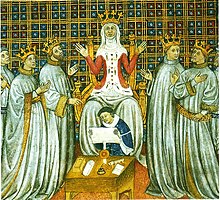Clotilde
Saint Clotilde | |
|---|---|
 A sculpture of Saint Clotilde, Notre-Dame de Corbeil, 12th century | |
| Queen of All the Franks | |
| Born | 475 Lyon, Burgundy |
| Died | 545 Tours, Francia |
| Venerated in | Roman Catholic Church |
| Canonized | Pre-Congregation |
| Feast | June 4 |
| Attributes | wearing a crown and holding a church; with a battle in the background, in memory of the Battle of Tolbiac. |
| Patronage | brides, adopted children, parents, exiles, widows, the lame |
Saint Clotilde (475–545), also known as Clothilde, Clotilda, Clotild, Rotilde or Chroctechildis, was the second wife of the Frankish king Clovis I, and a princess of the kingdom of Burgundy. Venerated as a saint by the Catholic Church, she was instrumental to her husband's famous conversion to Christianity and, in her later years, was known for her almsgiving and penitential works of mercy.
Biography

Clotilde was born at the Burgundian court of Lyon, the daughter of King Chilperic II of Burgundy. Upon the death of Chilperic's father King Gondioc in 473, he and his brothers Gundobad and Godegisel had divided their inheritance; Chilperic II apparently reigning at Lyon, Gundobald at Vienne and Godegesil at Geneva.
According to Gregory of Tours (538–594), Chilperic II was slain by his brother Gundobad in 493, and his wife drowned with a stone hung around her neck, while of his two daughters, Chrona took the veil and Clotilde was exiled - it is, however, assumed that this tale is apocryphal.[1] At the time of her exile she was put forward as a potential bride for the Merovingian Clovis, King of the Franks, who had just conquered northern Gaul. They were married in the same year.
The marriage produced the following children:
- Ingomer, died young
- Chlodomer (495–524), King of the Franks at Orléans from 511
- Childebert I (496–558), King of the Franks at Paris from 511
- Chlothar I (497–561), King of the Franks at Soissons from 511, King of all Franks from 558
- Clotilde (died 531), married Amalaric, King of the Visigoths
Clotilde was brought up in the Catholic faith and did not rest until her husband had abjured Arianism and embraced the Catholic faith. According to Gregory of Tours' Historia Francorum (History of the Franks), when Clotilde had their first child baptised, he died soon after. Clovis upbraided her; but when Chlodomer was born, she insisted on baptising him also. Although Chlodomer did indeed fall ill, he soon after recovered. More healthy children followed.[2]
Clotilde's victory came in 496, when Clovis converted to Christianity, baptised by Bishop Remigius of Reims on Christmas Day of that year. According to tradition, on the eve of the Battle of Tolbiac against the Alamanni, Clovis prayed to God, swearing to be baptised if he emerged victorious on the battlefield. When he did indeed triumph, Clovis readily took the faith. With him Clotilde built at Paris the Church of the Holy Apostles, afterwards known as the Abbey of St Genevieve.[1] After Clovis' death in 511, she retired to the Abbey of St. Martin at Tours.
Later years

In 523 Clotilde finally took revenge for the murder of her father, when she incited her sons against her cousin King Sigismund of Burgundy, the son of Gundobad, and provoked the Burgundian War, which led to Sigismund's deposition and imprisonment, and his assassination the following year. In turn, her eldest son Chlodomer was killed during the following Burgundian campaign under Sigismund's successor King Godomar at the Battle of Vézeronce. Her daughter, also named Clotilde, also died about this time. Clotilde tried in vain to protect the rights of her three grandsons, the children of Chlodomer, against the claims of her surviving sons Childebert and Chlothar. Chlothar had two of them killed, while only Clodoald (Cloud) managed to escape and later chose an ecclesiastical career. She was equally unsuccessful in her efforts to prevent the civil discords between her children.
After these failures, Clotilde appeared to dedicate herself to a saintly life. She occupied herself with the building of churches and monasteries, preferring to distance herself from the power struggles of the court.[3] Churches associated with her are located at Laon, Andelys and Rouen.
Clotilde died in 544 or 545 at Tours, of natural causes; she was buried at her husband's side, in the Church of the Holy Apostles (now the Abbey of St Genevieve).
Veneration
Clotilde's cult made her the patron of queens, widows, brides and even those in exile. In Normandy especially she was venerated as guarding the lame and those who suffered violent death and ill-tempered husbands. In art she is often depicted presiding over the baptism of Clovis, or as a suppliant at the shrine of Saint Martin. Several fine images of her remain, particularly in the 16th century stained glass window at Andelys. Her relics survived the French Revolution, and are housed in the church of St Leu in Paris.[2]
See also
References
- ^ a b "Saint Clotilda". Encyclopædia Britannica 1911. Retrieved 2012-07-13.
- ^ a b Farmer, David Hugh (1997). The Oxford dictionary of saints (4. ed. ed.). Oxford [u.a.]: Oxford Univ. Press. ISBN 9780192800589.
{{cite book}}:|edition=has extra text (help) - ^ "Saint Clotilda". Saints.SQPN.com. Retrieved 2012-07-13.
This article incorporates text from a publication now in the public domain: Chisholm, Hugh, ed. (1911). Encyclopædia Britannica (11th ed.). Cambridge University Press. {{cite encyclopedia}}: Missing or empty |title= (help)
